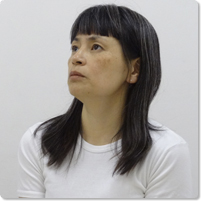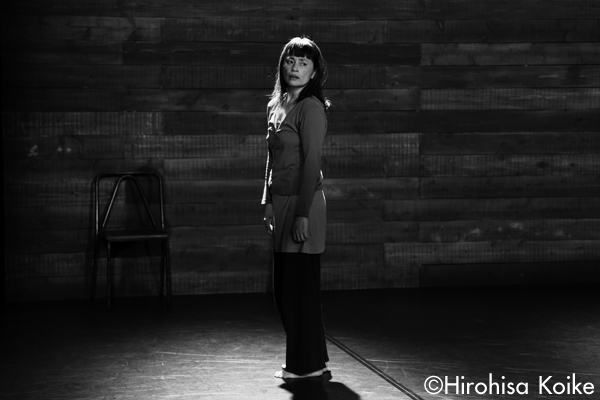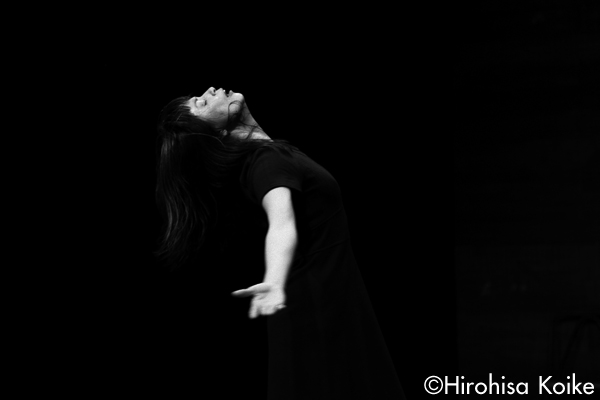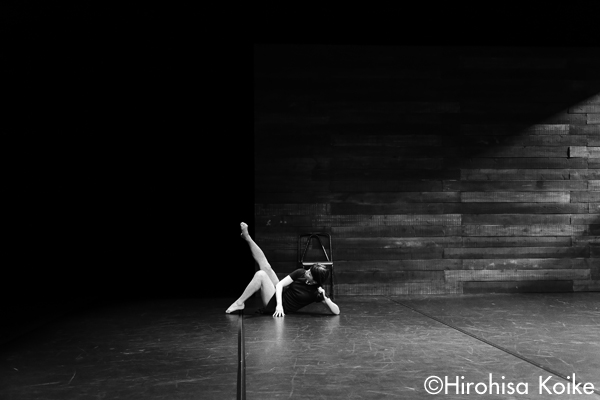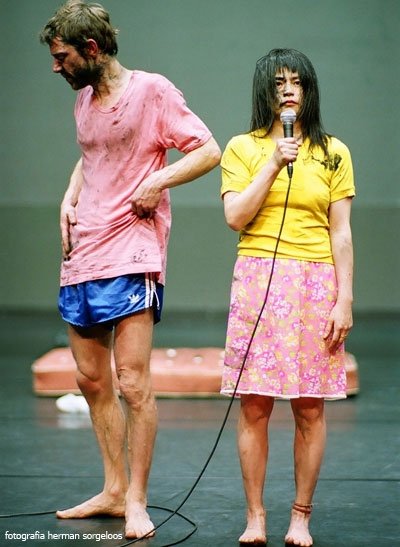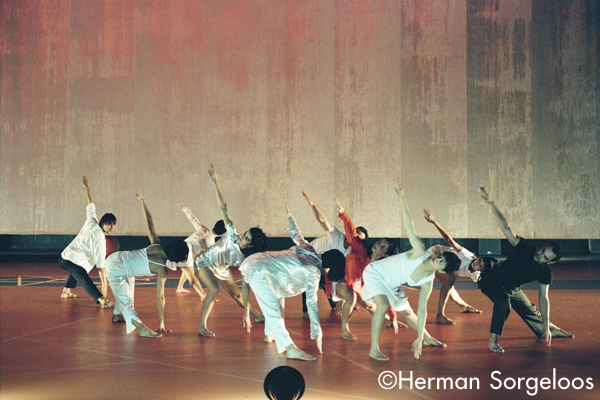About Ikeda’s most recent work in pieces
- I would like to begin by asking what prompted you to begin creating your own works.
-
Anne Teresa [De Keersmaeker] suggested that I try creating works of my own. And at that time she also advised me that rather than thinking about what I wanted to create, I might think about who I wanted to create something with. When I heard that I thought I wanted to create something with Benjamin [Verdonck]. He is a wild artist, and I was advised that it might also be good to have another person to coach me, even if he wasn’t going to actually appear on stage in the performance. So I asked Alain [Platel] to join us. That is how
Nine Finger
came to be created. For
in pieces
, the former Rosas artistic director Guy Gypens recommended that I work with Tim [Etchells]. I had never done a completely solo piece before, so I wanted to try creating one.
- Tim Etchells is a progressive artist known for his works that explore the potential of words. In your work in pieces you are constantly talking and moving throughout the performance. And you count all the way through giving a number to each line; “One. (something); Two. (something); Three. (something) …, with numbered part being a short scene expressing some emotion or some episode from your life. And that progression continues until the end. Did you expect to be doing that much talking in the piece?
-
Of course, I knew the type of works Tim created. For some reason, the works that have been invited to Japan in the past have been ones with no spoken parts, but in fact three-quarters of the Rosas works have spoken parts, so I am often speaking in our works. That may be something the Japanese audience didn’t expect.
- The image people in Japan have of Rosas was set by the first Japan performance in 1989 that consisted of pieces choreographed Bartok/Mikrokosmos music. That may be why it is difficult to bring Rosas works that have verbal parts to Japan. When I saw the [Rosas] work Kinoc performed at Belgium’s Kunsten Festival des Arts in 1994, I was impressed at what a different character it had from the Rosas works I was used to seeing in Japan.
-
Yes, I image you would be. By the way, the “Rosa” scene in
Kinoc
was one that I created. And, based on that scene, Peter Greenaway created a short video work titled
Rosa
(1992).
- Would you tell us about the creative process you used for in pieces ?
-
I was meeting with Tim several days each week to work on it, and after each session we would take home the unfinished parts to work on separately, and then at the next session we would show each other what we had come up. We wrote and found texts, created short dance sentences and analyzed music. Then we put together the pieces we had created in that way into a composition. There were some cases where I also rewrote parts of the texts Tim had written.
It has always been difficult creating works with Anne Teresa, because she is one who says with no hesitation that the opening performance is not the goal but merely another waypoint along the path. But in my case, both Nine Finger and in pieces where finished a week before the opening performance. A creative process where you just decide the important points and then value the developments that flow naturally from that framework suits my nature better. So, if I perform a piece 100 times each performance will be different, so I never get tired of it and never get used to it (laughs). Even if I practice reciting the text I will still make mistakes, I will still lose track of the numbers in the count, and since the dance is mostly improvisational, I don’t know how it will all turn out. I have no time to look back at what I have done, I just have to keep moving on to the next performance. I may think that one day’s [performance] has gone well, but the next day something completely different will happen, so they can’t be compared. It is best to forget the things that have happened. Things are arranged so that I can’t take myself to a place where I can feel secure and relaxed. That may be the best thing about this work.
- In the version performed in Japan there are English, Dutch and Japanese parts in the text. Of these, there is a long scene spoken in Dutch describing the events when an earthquake struck, and it appears as if you don’t want the audience to understand what was being said.
-
I decide what parts will be spoken in what language based on the country I am performing in. For example, in a country where English is understood I may take the parts that had been delivered in English and change them to Japanese. With the count as well, I did it in English for the first half and Japanese for the second half this time in Japan, but when I performed it in France I did the second half of the count in French. In countries where neither English nor French are commonly understood I have used subtitles instead.
As for the earthquake scene, I was talking about the earthquake in English once at lunch and Tim said, “Come to think of it, there is no part where you are delivering the lines smoothly in your native language,” so I decided to do it in Japanese at first.
When I performed in Japan, I did the earthquake scene in Dutch, and in other countries I do it in Japanese. [Even though the audience doesn’t understand the words] I repeat the same lines and gestures with the same emotional feeling and tone four times in succession, so the audience will begin to recognize the same words with the same gestures, and in that sense they are beginning to create “memories” from it.
- Now that you mention it, “memory” is the theme of in pieces , isn’t it?
-
Yes, it is. When Tim asked me what I wanted to do, I suggested that we do something on memory. It wasn’t about old stories. I wanted to think about memory itself. Since humans are comfortably subjective by nature we tend to remember things in conveniently reconstructed form, don’t we? I think that makes things interesting. People have very strong memories of events like the 9.11 terror attacks and the 3.11 earthquake and tsunami, but in 100 years the events will only be remembered as dates, and when more time passes they will end up as just one line of written memory in the chronology of history. When they are no longer talked about they become little more than dust blown to the wind. I am very interested in questions like how much something must be talked about to remain as memory.
- Do you think of this loss of memories as a poignant loss?
-
No. Because even as we live now, the things that happened a second before are already starting to fade away. I wanted to focus on how it fades away and is lost, and to think about memory and loss.
- It is a process of being aware of things being lost?
-
Yes! You could probably say that this has been my theme in the 30 years I have worked with Rosas. And, although she would never say so, I believe that Anne Teresa is concerned with the same thing. From the desire to lose yourself you want to relinquish the body, you become concerned with the concept of “loss,” including the desire to not lose things.
But, the other day I was teaching some young dancers using some of our early works, but I couldn’t see in them the desire to “lose oneself.” They don’t expose themselves fully. When we were young, we wanted to expose ourselves out on stage even when we reached the point where we were struggling for breath, and in Rosas we were trained not to hide the realities that occur, to show ourselves as we are, and that was the attitude that we deliberately developed. But, young dancers today don’t want to show themselves in that way, it seems that they feel they have to be cool, and this is something that Anne Teresa has been struggling with.
From Mudra to Rosas
- When Rosas first came to Japan it was a big inspiration for young Japanese dancers to discover that there was a Japanese dancer, and one of the founding members at that, in the popular and famous Belgian company. You were in your first year of high school when you entered the Mudra School (the dance school founded by Maurice Bejart as the associated school of the Theatre Royal de la Monnaie of Belgium). How did that come about?
-
I loved dance from childhood and I used to travel from my home in Fukui Prefecture to Tokyo to study ballet several times a month. But, I was worried about the future because I didn’t have confidence that I could make a living as a ballet dancer and I wasn’t sure if I wanted to end up being a ballet teacher in my hometown in Fukui. As I was worrying about what to do, I happened to see a notice in the newspaper or somewhere that the director of the Mudra School was visiting to Japan and several other countries (including Argentina, Brazil, Canada and others) holding auditions for his school, so I thought “This is it!”. I didn’t even have any idea who Bejart was or what kind of school Mudra was. That was in the days before the Internet, so I went to the audition with almost no information, and I was selected, just like that. That audition really changed my life.
- How many students were there in each year’s class?
-
About 50 were accepted that year. There were a few other Japanese in the class, too, but in the end only eight students remained overall. In the morning we would have classic and modern dance classes, then after noon we had acting and singing classes, so I was dancing every day until after six in the evening. I had never been that immersed in dance before, and it didn’t even leave me time to get homesick.
- So, that is where you met [Anne Teresa] De Keersmaeker?
-
Anne Teresa was in the class one year above mine, and in my class there was Reona Hirota. Anne Teresa didn’t stay for her third year but went to study at a school in America instead. I went on to my third year at Mudra, and with the eight people that were left in our class we were busy every day creating works and performing them. Anne Teresa came to see our graduation performance and came up to me after the performance and said, “You are going to work with me!” She had just come back from two years studying in the U.S. and it was just one month before the premiere of her evening piece
Fours
made up four short pieces, which our Mudra classmate Michele-Anne De Mey had joined in. I didn’t know anything about what kind of work Anne Teresa was interested in, but I knew that I loved her as a person, so I said, “OK, I’ll work with you.” (Laughs)
- This was before you began to use the name Rosas, right?
-
That’s right. It was a group of four with Anne Teresa, Michele-Anne, Adriana Borriello and myself. We rented a studio jointly with several companies like the predecessor to Need Company, and it worked like a living commune there, when one company was rehearsing, the others would be out working to earn money to be divided up between everyone. Gradually when we came to be recognized we started getting grants from the Belgian government. There are a number of different forms of grants for artists in Belgium, including 4-year ongoing grants, grants for specific productions and individual artist grants. What we eventually got was the 4-year ongoing grants and we continue to operate with those grants today.
- How was your first work Rosas Dance Rosas created? The music for that work was created by Michele-Anne De Mey’s older brother, Thierry De Mey, who has been a key figure in Belgium’s music world.
-
Thierry is an artist that Anne Teresa admires and I believe to be a major influence on her. The work
Rosas Dance Rosas
was one that seemed to take form along with Thierry’s music. He would say things like, “This is what I want to do with the music here, so I want you to move four times here.” In that way, we created the structure of the work together.
At first we didn’t have a group name or a title for the work, so the producers were getting angry. After a lot of hard thinking, we came to the idea that we could name our group Rosas and title the work Rosas Dance Rosas (laughs). The premiere was at Theatre de la Balsamine, created from a renovated army barracks in Brussels. I was 20 and Anne Teresa was 22. We were very young.
- When Rosas started out in the 1980s, Belgium had a number of internationally recognized artists, such as Crépuscule in music, and the Antwerp 6 in design. In the political arena as well, there was a lot of activity in Brussels due to factors like the central role it played in the predecessor of the EU, the European Communities.
-
In Brussels at the time, besides us there was Need Company, and Jan Faber had begun to be active. Another big presence was the producer
Hugo De Greef
, who was like a godfather on the arts scene, taking care of us and nurturing young artists.
- Eventually, Rosas would be based at Bejart’s Theatre Royal de la Monnaie. Did things go well for you up until you reached that point?
-
No. It was a tough road reaching that point. We had to do everything by ourselves, from transporting our equipment to the theater and setting up the stage to laundering our costumes. When we came to be invited to festivals in other countries, it was before the time of the euro, so the currency was different in every country and all payments had to be made in cash. That meant that when on tour we had to carry around large amounts of cash in a handbag, and someone would forget it in a telephone box. We were all doing stupid things like that (laughs). After Anne Teresa became the person in charge of the dance department of Theatre Royal de la Monnaie in 1992, we were their resident company for 15 years. But, since the new director came in with a new policy of not having resident companies, we have had to make our base at our own studio. But, the relationship with the theater is still a good one, and if Anne Teresa wants to do the premiere of a new work there we can, and it is credited in my work
in pieces
.
- The first to invite Rosas to Japan in 1989 after you received international recognition was the Yokohama Art Wave, a now legendary event. By bringing some of the world’s leading contemporary dance companies to perform on its program, the Yokohama Art Wave had a big impact on Japan’s young dancers. At that time Rosas performed three works, Mikrokosmos, Monument/Self-Portrait/Movement and QUATUORNO.4 . While being minimal in nature, these Rosas works had a nice emotional atmosphere that was different from the mechanical quality of American post-modern dance. They were tight but comfortable and very appealing to many here in Japan as a new and unexpected kind of dance.
-
You are right in saying that these works were not mechanical, and I would say there is a lot of heart in the movement. Anne Teresa creates movement base on a very complete analysis of the music. She assigns colors to each measure of the musical score and does a thorough analysis of the music with notes like, “The relationship between themes A and B is such-and-such they mirror each other at this point,” so creates the dance movement in a way that the musical score can be visualized. All of us get the musical score so thoroughly in our heads, as the musicians change, you may find us pointing out things like, “I didn’t hear that note,” or “Shouldn’t it actually be played such-and-such a way?” But no matter how thoroughly everything is analyzed, there is still something that can’t be analyzed. I think that is the unique warmth of the movement Anne Teresa creates, that movement that makes the dancer want to dance.
Rosas Today
- Why is it that Rosas and companies from 30 years ago are still more interesting than the younger generation?
-
It may be that the times have come around full circle. It seems that, not only for Rosas but for Wim Vandekeybus and for Jan Fabre, when we perform our old works again the audiences are really pleased. Since we now have a new, younger generation of directors, we hear requests like, these [old] works that we only know from DVDs, we want to see them performed live.” There are also some theaters that are presenting programs with a mix of 1980s works and new works in order to nurture their audience. I think we may have come full cycle to a time when, rather than conceptual, self-conscious, all-in-the-head works, people want to see dance that can suddenly bring tears to their eyes or make them laugh.
- I heard that as a Rosas 30th anniversary program you did revival performances of a group of early works from the 80s. How was the response?
-
Regardless of age, they all seemed to enjoy the performances. For example,
Elena’s Aria
uses a very slow timeframe, and for doing a restaging of it we were worried that it might not fit with the speed of life today. Even for us, the performers, our sense of time is different from what it used to be, and although it is a piece where we have to wait until the audience is thinking, “Isn’t anything going to happen?” before we finally move, we find ourselves wanting to move too early (laughs). Back when the piece premiered it wasn’t received well because of that slowness, but we found that the recent audiences enjoyed it with an appreciation of it unique [slow] speed. My daughter said it was interesting and she enjoyed watching the whole thing. This experience of restaging the old works after a long time made me realize the importance of approaching the works again with a questioning mind as part of the process of leaving the works for posterity.
- Contemporary dance may have reached the stage where preparations have to be made to hand it down to the next generation.
-
That is really true. At Rosas now we are continuing a series of performances under the title “Early Pieces,” where we rotate on a daily basis our works from the 1980s like
Fours
and
Rosas Dance Rosas
,
Elena’s Aria
and
Bartok/Mikrokosmos
. I believe Anne Teresa has become conscious of this need too, because in 2012 we released a book with a DVD analyzing these four works. Now a book analyzing
Rain
and
Drumming
is being produced. It is unfortunate that Pina [Bausch] died before she could leave behind documents like this. But, Merce Cunningham is now doing the same thing.
- What kinds of works is Rosas performing now?
-
In 2012, we are touring with nine works. They are
En Atendant, Cesena, Drumming
,
3 Abschied
,
The Song
,
Bartok/Mikrokosmos
,
Elena’s Aria
,
Rosas danst Rosas
and
Fase
. I perform in two of these nine and for two works I serve as rehearsal director (person responsible at the performance destination), and at the same time I am performing my own creations. I believe there are now five permanent members constituting Rosas and another thirty or so dancers are contracted to perform the individual works. Some of the works like
Cesena
(12 dancers and 12 singers) and
Drumming
(12 dancers and 12 musicians) involve large numbers of performers, and that means a lot of work. We also have two groups of technicians.
- You are also constantly working on new pieces as well, aren’t you?
-
That’s right. In my case, in addition to
in pieces
, I have done collaborative productions with the Nature Theater of Oklahoma in the United States. Anne Teresa is also working ambitiously on new works. For example,
Cesena
premiered last year at the Avignon Festival. This is a work that is performed starting at 5:00 in the morning and runs until 7:00 in the morning, beginning in the complete dark before sunrise and gradually becomes visible before the end as the morning light and sunrise come. Because there is very little cost involved in the stage art and very little electricity is used, it is a work that explores a new level of “economy and ecology.” Despite the irregular time, an audience of about 2,000 people came to the performance(s).
However, the people who are brought in as directors at the large festivals in all the countries are the same group of people. It’s gotten to be like an alumnus club. And because they are often selecting the works they bring to their festivals based on information from each other, without actually going to see the works performed, so the programs all begin to look the same. They have to just look at DVDs, and those are usually short, condensed versions. It is really a dangerous state of affairs.
- Rosas also runs a school named P.A.R.T.S. to train young dancers.
-
Yes. Today, most of the Rosas dancers are graduates of P.A.R.T.S. They have already started preparations for a 17th or 18th year cycle, and in fact they are now preparing to hold auditions in Japan for the school like Mudra did in the past. I will be doing the first-stage auditions in Japan and we will have the people who pass the audition then take classes similar to those at P.A.R.T.S. in Brussels. Anne Teresa will participate in the selections, and eventually we plan to select several students from Japan and some 40 to 50 overall [from other countries] to enter P.A.R.T.S. as first year students.
- That’s amazing!
-
The aim is to find uncut gems that will eventually shine. In the past we had about three young people who had only done hip hop, but by taking classes every day they soon became able to do a variety of different types of dance. At P.A.R.T.S. the students will be asked from an early stage to find out whether they want to dance or whether they want to create works. The important thing is not how many pirouettes you can do, but that you have a strong will and desire to do something at P.A.R.T.S.
At present it is a 4-year school, but there are plans now to create a 3-year PhD course and a 2-year Masters course. We have the student performing on our tours and creating works and giving performances at real theaters, and many of our graduates are noticed by directors and commissioned to create works.
- In this age when it is hard internationally to maintain a large company, it is increasingly difficult to create a platform for nurturing young talent. So, I think that the attitude at P.A.R.T.S is a wonderful thing.
-
Anne Teresa says let’s think about what we can do now and what we should be doing, including your own performing on stage and other things. We think not only about teaching the younger generation but also continuously think about what creation we can be doing as active artists with the career experience we have today. And showing that attitude is also an important responsibility we have.
As her latest project, Anne Teresa is working on a duo work with Boris Charmatz. I am currently working on a collaboration with Un Yamada. Since we live far apart we are working on it over the Internet, and so, rather than talking on and on in a planning meeting we decided to send each other something, anything each day, even if it is only one or two words. And already it has accumulated into over 600 words (laughs). It is more stimulating than I ever imagined it would be, and I’m very excited to see how it will turn out. And, in 2014 I plan to present a work based on Junichiro Tanizaki’s The Key and in 2015 a work of Camille Claudel .
- We look forward to your new works. Thank you for taking so much time to talk to us today.
Rosas
Rosas is one of Belgium’s representative dance companies. It was founded in 1983 by Anne Teresa De Keersmaeker, who studied at the Mudra School founded by Maurice Bejart in Brussels and the Tisch School of the Arts in New York, and four fellow female dancers from the Mudra School. The group’s debut work was Rosas danst Rosas . From 1992 to 2007 Rosas was the resident dance company of the Theatre Royal de la Monnaie. The company’s progressive works are characterized by a pursuit of the relationship between the composition of the music and the physical movement. Recently, many of the company’s works have a theatrical orientation with considerable amounts of spoken script. Rosas has won many coveted awards such as the Bessie Award. The company has also collaborated in numerous film and video works with artists like Peter Greenaway.
https://www.rosas.be/


